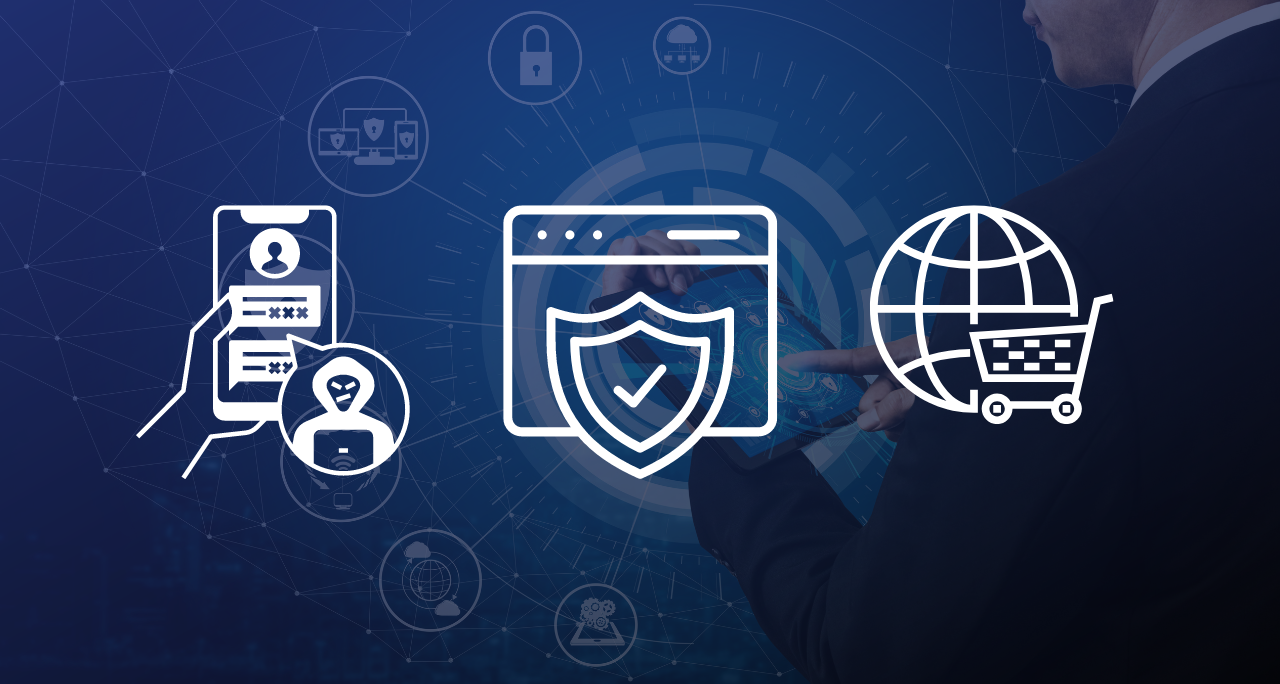Global eCommerce sales are expected to grow by 10.4% in 2023, with a projected revenue of over $6.51 trillion by the end of the year.
This expansion in the eCommerce market is spurred by the rapid adoption of online shopping by customers looking for a more personal shopping experience – something eCommercee is well positioned to deliver.
In fact, by the end of 2023, there will likely be more than 24 million individual eCommerce sites across the web. While this means there is significant potential for capital gain there are also many threats online merchants can encounter.
This article discusses the key eCommerce security threats facing vendors in 2023. We look at the potential damage which can be caused, and ways companies can safeguard themselves against these threats.

Phishing Attacks
Phishing attacks account for 1 in 5 data breaches worldwide. They are a type of social engineering threat involving emails and messages sent to individuals or customers, that appear to be from a legitimate sender but are, in fact, from cyber criminals.
These attacks aim to obtain sensitive personal information from eCommerce customers and staff, primarily credit card and payment details or usernames and passwords.
To reduce exposure to phishing attack threats, eCommerce businesses should educate their employees and customers about recognizing and avoiding phishing emails and messages. This includes features as email authentication, training sessions, as well as reminders to never share sensitive information.
Another effective prevention measure is implementing multi-factor authentication, which requires eCommerce platform users to provide a second verification step beyond just a password. This can include something the user knows (such as a PIN), something the user has (such as a security token), or something the user is (such as a biometric identifier).
Anti-phishing software can also detect and block phishing emails and messages before they reach their intended targets.

Payment Fraud
Payment fraud is expected to cost online businesses more than $200 billion in 2023. The threat occurs when an unauthorized individual performs transactions with stolen payment information, usually by stolen credit card details, identity theft, or chargeback fraud.
Unlike phishing attacks, which generally target the eCommerce customer’s bank, payment fraud threats focus on a payment platform.
Preventing payment fraud is more of a technical and procedural process when compared to the education-based prevention of phishing and other social engineering threats.
In particular, eCommerce businesses should use secure payment gateways that encrypt and protect sensitive customer data and should implement processes that identify customer information before any transaction is finalized. Finally, fraud detection software that can alert businesses to potentially fraudulent transactions can help companies reduce their exposure to payment fraud threats.
Corporate Account Take Over (CATO)
Another hugely costly type of fraud threat facing eCommerce businesses in 2023 is Corporate Account Take Over (CATO) threats.
This type of fraud involves gaining access to a company’s financial accounts and stealing money or other assets. These attacks typically rely on compromising the credentials of authorized users or employees and using those credentials to access the company’s financial systems. Preventative measures are the same as preventing payment fraud attacks.

Malware and Ransomware
Malware and ransomware are types of malicious software that pose significant threats to eCommerce businesses. The average cost of a ransom or malware attack is $1.85 million, making it a significant threat to online sellers around the world.
Malware is any software designed to harm or exploit computer systems. At the same time, ransomware is a variety of malware that locks down a computer system and demands a ransom in exchange for the release of that system.
Malware and ransomware can harm eCommerce businesses in several ways. They can steal sensitive customer information, interfere with business operations by encrypting important data or freezing computer systems, and cause indirect financial loss due to system downtime or reputational damage.
To prevent malware and ransomware attacks, eCommerce businesses should use antivirus software and firewalls to protect their systems. It’s also vital that online merchants keep their software up to date, as many attacks exploit vulnerabilities in outdated software. Companies should also avoid suspicious emails and downloads, as these can often contain malware or ransomware.
Another effective prevention measure is to regularly back up important data and files so that in the event of an attack, the business can restore its systems without having to pay a ransom. Education and staff training on identifying and reporting suspicious activity and implementing access controls to limit the impact of an attack are also recommended preventative methods.

Cross-Site Scripting (XSS) Attacks
Like malware and ransomware, cross-site scripting (XSS) threats are software/application-based. They work by injecting malicious code into a website, which can be executed in a victim’s browser when they visit the affected page. This allows an attacker to steal sensitive information, such as usernames and passwords, or to manipulate the content of the website.
Clickjacking
A common variety of XSS attacks is “clickjacking,” where the code injected into a website hides a malicious link or button near an interactive website element – such as a button – which the website user accidentally clicks when engaging with the content.
To prevent XSS attacks, eCommerce businesses can validate user input, sanitize website content, and avoid malicious code injection. eCommerce This includes implementing input validation checks that ensure user input contains only allowed characters and encoding special characters to prevent them from being interpreted as code.
Using web application firewalls (WAFs) is another way to mitigate XSS threats. WAFs inspect incoming traffic for pre-identified XSS attack patterns and block them before they reach the website. Additionally, eCommerce businesses can conduct regular vulnerability assessments and penetration testing to identify and fix any vulnerabilities in their web applications.
Keeping web applications up to date with security patches and updates is also vital for preventing XSS attacks. Many attacks exploit vulnerabilities in outdated software, so staying current with security updates can significantly reduce the risk of an attack.

Insider Threats
Insider threats are a type of cyber threat that comes from within an organization or eCommerce business.
They can be intentional, where an employee deliberately steals sensitive data or damages computer systems, or unintentional, such as an employee inadvertently exposing confidential information (like in phishing threats).
In fact, disgruntled employees who voluntarily or involuntarily leave an organization pose one of the most significant security risks to eCommerce businesses, as these individuals can maliciously steal and share sensitive information out of spite.
Therefore, having strict access control, which limits employee access to information and systems, is essential across all departments and levels within any organization or eCommerce business. This can include using role-based access controls that limit access to only those employees who need it and implementing two-factor authentication to prevent unauthorized access.
Monitoring employee activity is another effective prevention measure, as it can help detect and prevent suspicious activity before it becomes a problem. This might include recording network activity and user behavior, as well as implementing security information and event management (SIEM) tools that can detect anomalies and alert security teams.
As with other social engineering attacks, educating employees on data handling is essential to mitigate an eCommerce business’s exposure to insider threats. This includes encouraging employees to report suspicious behavior or activity and use proper password hygiene best practices.
Distributed Denial-of-Service (DDoS) Attacks
Distributed Denial-of-Service (DDoS) threats are a type of cyberattack that disrupt a website’s or online service’s availability by overwhelming it with traffic from multiple sources. They are incredibly prevalent, with one survey reporting nearly 70% of organizations experience multiple DDoS attacks each month.
DDoS attacks are launched with networks of compromised devices, such as Internet of Things devices, which are compromised and manipulated by a hacker. They are particularly harmful to eCommerce businesses, as they disrupt website availability, which causes loss of revenue, and damages customer loyalty.
To prevent DDoS attacks,eCommerce businesses can use a content delivery network (CDN) to distribute website traffic across multiple servers and data centers. In the event of a DDoS attack, a CDN network helps absorb and distribute the high volume of traffic by sending it to multiple isolated locations, thus preventing an overload of the website or service.
Monitoring network traffic is another effective prevention measure, as it can help detect and mitigate DDoS attacks in real time. Monitoring measures include implementing traffic analysis tools that can detect unusual traffic patterns and block traffic from suspicious sources.
DDoS protection software is also available to eCommerce businesses which can address DDoS attacks before they compromise website functionality. These services include features like traffic filtering, load balancing, and automatic scaling and can be customized to the business’s specific needs.

Social Engineering Attacks
Social engineering attacks are an umbrella term that defines any cyberattack achieved by manipulating human behavior to obtain sensitive information or access computer systems. They take many forms, including phishing scams, pretexting, baiting, and quid pro quo attacks, and rely on the victim’s trust or emotions to be successful.
As these attacks play on human nature and behavior, reducing an eCommerce business’ exposure to social engineering threats revolves around employee and customer education.
As mentioned in the phishing attack section above, this strategy includes providing thorough internal training on how to recognize suspicious emails or phone calls and maintaining employee and organizational vigilance to never share sensitive (information unless they can verify the requestor’s identity – which is another effective method for reducing exposure to social engineering attacks).
Online businesses significantly improve their chances of thwarting a social engineering attack when requiring customers and employees to provide additional information or documentation to verify their identity before granting access to sensitive information or systems.
Limited access to sensitive information is another effective prevention measure. By restricting access to tiers of internal data on a need-to-know basis, eCommerce businesses can reduce the risk of social engineering attacks by lowering the number of employees with access to sensitive information.
The Takeaway
In 2023, eCommerce businesses should be on the lookout for several crucial threats, including social engineering threats, fraud, and software/application threats.
As the use of online shopping and digital payments continues to grow, cybercriminals and their skillsets become increasingly sophisticated in exploiting vulnerabilities in digital systems.
It’s crucial for businesses to prioritize eCommerce security to protect their customers’ personal and financial information and maintain their reputation. The alternate scenario? Security breaches will inevitably lead to significant financial and reputational damage, directly resulting in lost customers and revenue.
By learning about the types of threats and how to protect their businesses from them, eCommerce companies can reduce their exposure and the risk of falling victim to cybersecurity attacks in 2023.
Author Bio

Irina Maltseva is a Growth Lead at Aura and a Founder at ONSAAS. For the last seven years, she has been helping SaaS companies to grow their revenue with inbound marketing. At her previous company, Hunter, Irina helped 3M marketers to build business connections that matter. Now, at Aura, Irina is working on her mission to create a safer internet for everyone. To get in touch, follow her on LinkedIn.





